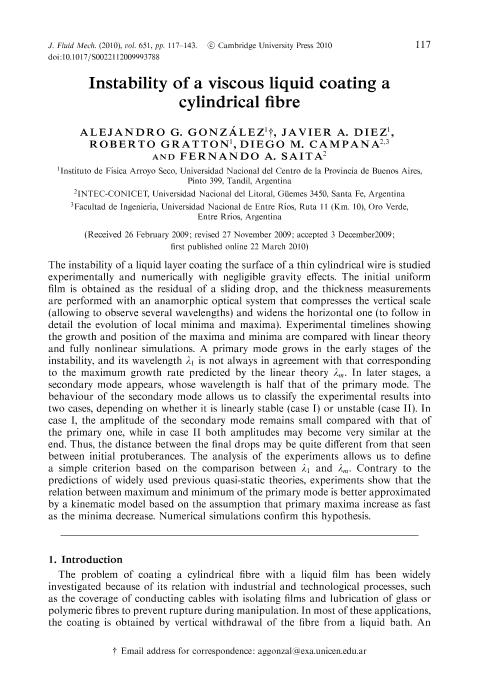Artículo
Instability of a viscous liquid coating a cylindrical fibre
Gonzalez, Alejandro Guillermo ; Diez, Javier Alberto
; Diez, Javier Alberto ; Gratton, Roberto
; Gratton, Roberto ; Campana, Diego Martin
; Campana, Diego Martin ; Saita, Fernando Adolfo
; Saita, Fernando Adolfo
 ; Diez, Javier Alberto
; Diez, Javier Alberto ; Gratton, Roberto
; Gratton, Roberto ; Campana, Diego Martin
; Campana, Diego Martin ; Saita, Fernando Adolfo
; Saita, Fernando Adolfo
Fecha de publicación:
05/2010
Editorial:
Cambridge University Press
Revista:
Journal Of Fluid Mechanics
ISSN:
0022-1120
Idioma:
Inglés
Tipo de recurso:
Artículo publicado
Clasificación temática:
Resumen
The instability of a liquid layer coating the surface of a thin cylindrical wire is studied experimentally and numerically with negligible gravity effects. The initial uniform film is obtained as the residual of a sliding drop, and the thickness measurements are performed with an anamorphic optical system that compresses the vertical scale (allowing to observe several wavelengths) and widens the horizontal one (to follow in detail the evolution of local minima and maxima). Experimental timelines showing the growth and position of the maxima and minima are compared with linear theory and fully nonlinear simulations. A primary mode grows in the early stages of the instability, and its wavelength lamda1 is not always in agreement with that corresponding to the maximum growth rate predicted by the linear theory lamdam. In later stages, a secondary mode appears, whose wavelength is half that of the primary mode. The behaviour of the secondary mode allows us to classify the experimental results into two cases, depending on whether it is linearly stable (case I) or unstable (case II). In case I, the amplitude of the secondary mode remains small compared with that of the primary one, while in case II both amplitudes may become very similar at the end. Thus, the distance between the final drops may be quite different from that seen between initial protuberances. The analysis of the experiments allows us to define a simple criterion based on the comparison between lamda1 and lamdam. Contrary to the predictions of widely used previous quasi-static theories, experiments show that the relation between maximum and minimum of the primary mode is better approximated by a kinematic model based on the assumption that primary maxima increase as fast as the minima decrease. Numerical simulations confirm this hypothesis.
Palabras clave:
Coating
,
Instability
,
Drops
Archivos asociados
Licencia
Identificadores
Colecciones
Articulos(INTEC)
Articulos de INST.DE DES.TECNOL.PARA LA IND.QUIMICA (I)
Articulos de INST.DE DES.TECNOL.PARA LA IND.QUIMICA (I)
Citación
Gonzalez, Alejandro Guillermo; Diez, Javier Alberto; Gratton, Roberto; Campana, Diego Martin; Saita, Fernando Adolfo; Instability of a viscous liquid coating a cylindrical fibre; Cambridge University Press; Journal Of Fluid Mechanics; 651; 5-2010; 117-143
Compartir
Altmétricas



